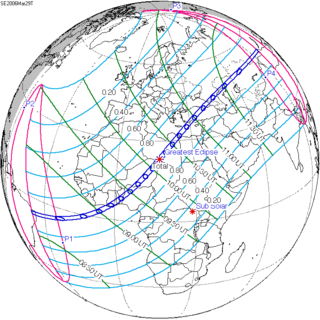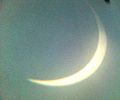Solar eclipse of March 29, 2006
| Solar eclipse of March 29, 2006 | |
|---|---|
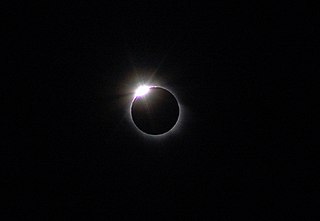 Totality from Side, Turkey | |
| Type of eclipse | |
| Nature | Total |
| Gamma | 0.3843 |
| Magnitude | 1.0515 |
| Maximum eclipse | |
| Duration | 247 s (4 min 7 s) |
| Coordinates | 23°12′N 16°42′E / 23.2°N 16.7°E |
| Max. width of band | 184 km (114 mi) |
| Times (UTC) | |
| (P1) Partial begin | 7:36:50 |
| (U1) Total begin | 8:34:20 |
| Greatest eclipse | 10:12:23 |
| (U4) Total end | 11:47:55 |
| (P4) Partial end | 12:45:35 |
| References | |
| Saros | 139 (29 of 71) |
| Catalog # (SE5000) | 9521 |
A total solar eclipse occurred on March 29, 2006.[1][2] A solar eclipse occurs when the Moon passes between Earth and the Sun, thereby totally or partly obscuring the image of the Sun for a viewer on Earth. A total solar eclipse occurs when the Moon's apparent diameter is larger than the Sun's, blocking all direct sunlight, turning day into darkness. Totality occurs in a narrow path across Earth's surface, with the partial solar eclipse visible over a surrounding region thousands of kilometres wide. It was visible from a narrow corridor which traversed half the Earth. The magnitude, that is, the ratio between the apparent sizes of the Moon and that of the Sun, was 1.052, and it was part of Saros 139.
It was the second solar eclipse visible in Africa in just 6 months.
Visibility[edit]

The path of totality of the Moon's shadow began at sunrise in Brazil and extended across the Atlantic to Africa, traveling across Ghana, the southeastern tip of Ivory Coast, Togo, Benin, Nigeria, Niger, Chad, Libya, and a small corner of northwest Egypt, from there across the Mediterranean Sea to Greece (Kastellórizo) and Turkey, then across the Black Sea via Georgia, Russia, and Kazakhstan to Western Mongolia, where it ended at sunset. A partial eclipse was seen from the much broader path of the Moon's penumbra, including the northern two-thirds of Africa, the whole of Europe, and Central Asia.
Observations[edit]
People around the world gathered in areas where the eclipse was visible to view the event. The Manchester Astronomical Society, the Malaysian Space Agency, the Astronomical Society of the Pacific, as well as dozens of tour groups met at the Apollo temple and the theater in Side, Turkey. The San Francisco Exploratorium featured a live webcast from the site, where thousands of observers were seated in the ancient, Roman-style theater.[3]
Almost all actively visited areas in the path of totality had perfect weather. Many observers reported an unusually beautiful eclipse, with many or all effects visible, and a very nice corona, despite the proximity to the solar minimum. The partial phase of the eclipse was also visible from the International Space Station, where the astronauts on board took spectacular pictures of the moon's shadow on Earth's surface. It initially appeared as though an orbit correction set for the middle of March would bring the ISS into the path of totality, but this correction was postponed.
The Paris Observatory sent a team of students and coordinators to Savalou, Benin. The team took clear images of the corona. A team of Williams College, Massachusetts did many experiments and took images of the corona on the Greek island of Kastellórizo with 3 minutes of totality, which is close to the coast of Turkey and the only place in the European Union covered by the path of totality. The Solar and Heliospheric Observatory also made auxiliary observations to compare images taken from space and from the ground[4][5][6]. Another research simulated the changing colours of the sky in the path of totality with a three-dimensional model while considering multiple scattering. Monte Carlo method was used in the experiment to predict the colour and brightness of the sky. In addition, the direct irradiation of the corona was also studied. The goal was to plan and optimise studies on incoming solar irradiance[7]. Russian scientists studied on coronal polarization in the Baksan River Gorge surrounded by snow mountains in the North Caucasus. The location has an altitude of 1,800 metres and is 25 kilometres from Mount Elbrus, the highest peak in Russia and also Europe[8].
Libya under Muammar Gaddafi was under sanctions because of bombing the Pan Am Flight 103 and had a strict alcohol ban. It was the least visited region around the Mediterranean. To promote tourism, the Libyan government mobilized 5 state-owned tourism companies to attract more tourists, and built a tent village that could accommodate 7,000 people in Waw an Namus inside the Sahara Desert with excellent observation conditions. However, it was only open to astronomers, while ordinary tourists were directed to Patan, near the border with Egypt. Despite Libya's desire to attract tourists from all over the world, Israelis were still banned from entering the country[9][10]. NASA scientists also did joint observation and research with Libyan scientists, taking images and videos[6][11].
A team of 20 people from the Chinese Astronomical Society took images of Baily's beads, corona and prominences in Sallum, Egypt. The weather conditions were good in Sallum and also neighbouring Libya. Then Egyptian President Hosni Mubarak, Minister of Defense Muhammad Tantawi and other officials also went there by helicopter and observed the eclipse with scientists and tourists[12][13].
Gallery[edit]
-
Cape Coast, Ghana (9:10 UTC)
-
Murzuq District, Libya (10:16 UTC)
-
Valencia, Spain (10:16 UTC)
-
Oria, Italy (10:39 UTC)
-
The Moon's shadow as seen from the International Space Station (10:50 UTC)
-
Berkhamsted, England (11:01 UTC)
-
Marousi, Greece (11:01 UTC)
-
Krasnoyarsk, Russia (11:20 UTC)
-
Lagan, Russia (11:23 UTC)
-
Novosibirsk, Russia (11:42 UTC)
-
Kathmandu, Nepal (12:01 UTC)
-
Degania A, Israel: Partial Solar Eclipse
-
Animation from Sallum, Egypt
Satellite failure[edit]
The satellite responsible for SKY Network Television, a New Zealand pay TV company, failed the day after this eclipse at around 1900 local time. While SKY didn't directly attribute the failure to the eclipse, they said in a media release that it took longer to resolve the issue because of it, but this claim was rejected by astronomers. The main reason for the failure was because of an aging and increasingly faulty satellite.[14]
Related eclipses[edit]
Eclipses of 2006[edit]
- A penumbral lunar eclipse on March 14.
- A total solar eclipse on March 29.
- A partial lunar eclipse on September 7.
- An annular solar eclipse on September 22.
This solar eclipse was preceded by the penumbral lunar eclipse on March 14, 2006.
Tzolkinex[edit]
- Preceded: Solar eclipse of February 16, 1999
- Followed: Solar eclipse of May 10, 2013
Half-Saros[edit]
- Preceded: Lunar eclipse of March 24, 1997
- Followed: Lunar eclipse of April 4, 2015
Tritos[edit]
- Preceded: Solar eclipse of April 29, 1995
- Followed: Solar eclipse of February 26, 2017
Solar Saros 139[edit]
- Preceded: Solar eclipse of March 18, 1988
- Followed: Solar eclipse of April 8, 2024
Inex[edit]
- Preceded: Solar eclipse of April 18, 1977
- Followed: Solar eclipse of March 9, 2035
Solar eclipses 2004–2007[edit]
This eclipse is a member of a semester series. An eclipse in a semester series of solar eclipses repeats approximately every 177 days and 4 hours (a semester) at alternating nodes of the Moon's orbit.[15]
| Ascending node | Descending node | |||||
|---|---|---|---|---|---|---|
| Saros | Map | Gamma | Saros | Map | Gamma | |
| 119 | 2004 April 19 Partial (south) |
−1.13345 | 124 | 2004 October 14 Partial (north) |
1.03481 | |
129 Partial from Naiguatá |
2005 April 08 Hybrid |
−0.34733 | 134 Annular from Madrid, Spain |
2005 October 03 Annular |
0.33058 | |
139 Total from Side, Turkey |
2006 March 29 Total |
0.38433 | 144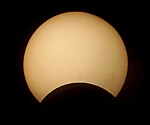 Partial from São Paulo, Brazil |
2006 September 22 Annular |
−0.40624 | |
149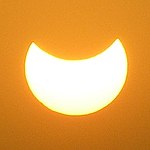 From Jaipur, India |
2007 March 19 Partial (north) |
1.07277 | 154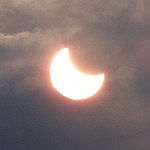 From Córdoba, Argentina |
2007 September 11 Partial (south) |
−1.12552 | |
Saros 139[edit]
This eclipse is a member of saros series 139, repeating every 18 years, 11 days, 8 hours, containing 71 events. The series started with partial solar eclipse on May 17, 1501. It contains hybrid eclipses on August 11, 1627, through to December 9, 1825; and total eclipses from December 21, 1843, through to March 26, 2601. The series ends at member 71 as a partial eclipse on July 3, 2763. Its eclipses are tabulated in three columns; every third eclipse in the same column is one exeligmos apart, so they all cast shadows over approximately the same parts of the Earth.
The solar eclipse of June 13, 2132, will be the longest total solar eclipse since July 11, 1991, at 6 minutes, 55.02 seconds.
The longest duration of totality will be produced by member 39 at 7 minutes, 29.22 seconds on July 16, 2186.[16] After that date, the durations of totality will decrease until the series ends. This date is the longest solar eclipse computed between 4000 BC and AD 6000.[17] Saros series eclipses occur during the Moon's ascending node (a term related to our equator and polar-naming conventions).
| Series members 24–45 occur between 1901 and 2300 | ||
|---|---|---|
| 24 | 25 | 26 |
 February 3, 1916 |
 February 14, 1934 |
 February 25, 1952 |
| 27 | 28 | 29 |
 March 7, 1970 |
 March 18, 1988 |
 March 29, 2006 |
| 30 | 31 | 32 |
 April 8, 2024 |
 April 20, 2042 |
 April 30, 2060 |
| 33 | 34 | 35 |
 May 11, 2078 |
 May 22, 2096 |
 June 3, 2114 |
| 36 | 37 | 38 |
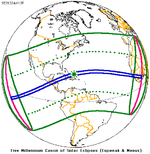 June 13, 2132 |
 June 25, 2150 |
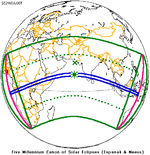 July 5, 2168 |
| 39 | 40 | 41 |
 July 16, 2186 |
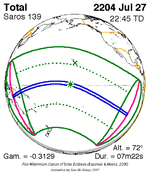 July 27, 2204 |
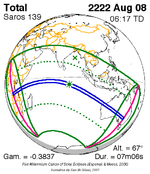 August 8, 2222 |
| 42 | 43 | 44 |
 August 18, 2240 |
 August 29, 2258 |
 September 9, 2276 |
| 45 | ||
 September 20, 2294 | ||
Inex series[edit]
This eclipse is a part of the long period inex cycle, repeating at alternating nodes, every 358 synodic months (≈ 10,571.95 days, or 29 years minus 20 days). Their appearance and longitude are irregular due to a lack of synchronization with the anomalistic month (period of perigee). However, groupings of 3 inex cycles (≈ 87 years minus 2 months) comes close (≈ 1,151.02 anomalistic months), so eclipses are similar in these groupings.
| Inex series members between 1901 and 2100: | ||
|---|---|---|
 May 29, 1919 (Saros 136) |
 May 9, 1948 (Saros 137) |
 April 18, 1977 (Saros 138) |
 March 29, 2006 (Saros 139) |
 March 9, 2035 (Saros 140) |
 February 17, 2064 (Saros 141) |
 January 27, 2093 (Saros 142) |
||
Metonic series[edit]
The metonic series repeats eclipses every 19 years (6939.69 days), lasting about 5 cycles. Eclipses occur in nearly the same calendar date. In addition, the octon subseries repeats 1/5 of that or every 3.8 years (1387.94 days). All eclipses in this table occur at the Moon's ascending node.
| 21 eclipse events, progressing from south to north between June 10, 1964, and August 21, 2036 | ||||
|---|---|---|---|---|
| June 10–11 | March 27–29 | January 15–16 | November 3 | August 21–22 |
| 117 | 119 | 121 | 123 | 125 |
 June 10, 1964 |
 March 28, 1968 |
 January 16, 1972 |
 November 3, 1975 |
 August 22, 1979 |
| 127 | 129 | 131 | 133 | 135 |
 June 11, 1983 |
 March 29, 1987 |
 January 15, 1991 |
 November 3, 1994 |
 August 22, 1998 |
| 137 | 139 | 141 | 143 | 145 |
 June 10, 2002 |
 March 29, 2006 |
 January 15, 2010 |
 November 3, 2013 |
 August 21, 2017 |
| 147 | 149 | 151 | 153 | 155 |
 June 10, 2021 |
 March 29, 2025 |
 January 14, 2029 |
 November 3, 2032 |
 August 21, 2036 |
Notes[edit]
- ^ "Total solar eclipse: World witnesses rare event". Bristol Herald Courier. 2006-03-30. p. 4. Retrieved 2023-10-25 – via Newspapers.com.
- ^ "There goes the sun". The Toronto Star. 2006-03-30. p. 3. Retrieved 2023-10-25 – via Newspapers.com.
- ^ Total Solar Eclipse: Live from Turkey in 2006
- ^ "Total Solar Eclipse 2006". European Space Agency. 30 March 2006. Archived from the original on 19 August 2015.
- ^ "Solar Eclipse on 29 March 2006". Solar and Heliospheric Observatory. Archived from the original on 17 July 2006.
- ^ a b "NASA Shares Solar Eclipses With the World". NASA. 28 March 2006. Archived from the original on 13 August 2015.
- ^ C. Emde, B. Mayer: Simulation of solar radiation during a total eclipse: a challenge for radiative transfer [28 August 2015]
- ^ "ВЗАИМОДЕЙСТВИЕ ПОЛЯРИЗАЦИОННОГО ИЗЛУЧЕНИЯ КОРОНЫ И ЗОРЕВОГО КОЛЬЦА 29.03.2006 г." (in Russian). IZMIRAN. Archived from the original on 27 February 2012.
- ^ Xu Haijing (30 March 2006). "利比亚:欢迎来看日全食" (in Chinese). Yangcheng Evening News. Archived from the original on 19 August 2015.
- ^ "欲靠"老天"打开局面 利比亚推出日全食旅游". China News Service (in Chinese). Sina news. 28 March 2005. Archived from the original on 19 August 2015.
- ^ "Solar Eclipse 2006 Video". NASA. nasamike.com. Archived from the original on 4 March 2016.
- ^ Meng Tie (1 April 2006). "我和埃及总统一起看日全食". Hangzhou Daily (in Chinese). Archived from the original on 24 September 2015.
- ^ "【图】埃及医生:穆巴拉克未"临床死亡"" (in Chinese). Xinhua News Agency. Archived from the original on 19 August 2015.
- ^ Press release by Sky TV. Solar eclipse interferes with satellite restoration Archived 2005-02-10 at the Wayback Machine Friday, 31 March 2006.
- ^ van Gent, R.H. "Solar- and Lunar-Eclipse Predictions from Antiquity to the Present". A Catalogue of Eclipse Cycles. Utrecht University. Retrieved 6 October 2018.
- ^ Saros Series Catalog of Solar Eclipses NASA Eclipse Web Site.
- ^ Ten Millennium Catalog of Long Solar Eclipses, −3999 to +6000 (4000 BCE to 6000 CE) Fred Espenak.
References[edit]
- Fred Espenak and Jay Anderson. "Total Solar Eclipse of 2006 March 29". NASA Technical publication (NASA/TP-2004-212762), November 2004.
- NASA – Total Solar Eclipse of 2006 March 29
- Earth visibility chart and eclipse statistics Eclipse Predictions by Fred Espenak, NASA/GSFC
- solar-eclipse-2006.info Information about the March 29th Solar Eclipse.
- Interactive 2006 March 29 Total Solar Eclipse map with local circumstances
- Eclipse.za.net, Umbral Paths of March 29 Eclipse in Africa
Photos:
- Prof. Druckmüller's eclipse photography site. Turkey, Cappadocia
- Prof. Druckmüller's eclipse photography site. Egypt
- Prof. Druckmüller's eclipse photography site. Libya
- Total eclipse photographs from Turkey
- Another set of total eclipse photographs from Turkey
- Photo gallery from Turkey
- Phases of solar eclipse view from Antalya
- NASA videos and photos from Libya and Turkey
- Pictures taken from Smolyan, Bulgaria
- NASA video of eclipse Archived 2007-03-10 at the Wayback Machine
- Solar eclipse images and videos from Libya by traveling NASA employees and scientists
- Images by Crayford Manor House Astronomical Society from Libya and Turkey Archived 2013-02-09 at archive.today
- Spaceweather.com Eclipse gallery
- Antwrp.gsfc.nasa.gov APOD, March 30, 2006, When Diamonds Aren't Forever, totality from Greek island of Kastelorizo in the eastern Aegean
- Antwrp.gsfc.nasa.gov APOD, April 4, 2006, A Total Solar Eclipse over Turkey, totality from Adrasan, Kumluca, Antalya Province, Turkey
- Antwrp.gsfc.nasa.gov APOD, April 7, 2006, totality from Side, Turkey, a larger version of the same picture chosen as APOD again on July 26, 2009, The Big Corona, Koenvangorp.be
- Antwrp.gsfc.nasa.gov APOD, April 8, 2006, Vanishing Umbra, from Mount Hasan southeast of İncesu, Aksaray, Turkey
- The 2006 Eclipse in Turkey
- Russian scientist observed eclipse
- University of Athens – Solar Eclipse 29/3/2006, Solar Party
- Solar Total Eclipse of 2006 March 29
- Tubitak.gov.tr, 29 March 2006 Total Solar Eclipse, Scientific and Technological Research Council of Turkey (TÜBİTAK)
- Solar Eclipse over Kemer, Turkey 060329
External links[edit]
![]() Media related to Solar eclipse of 2006 March 29 at Wikimedia Commons
Media related to Solar eclipse of 2006 March 29 at Wikimedia Commons

